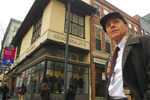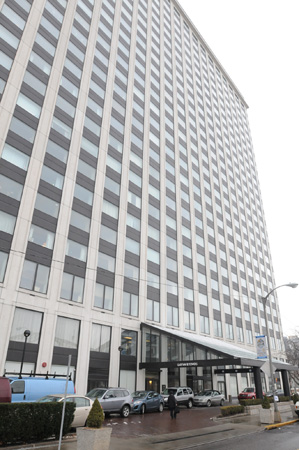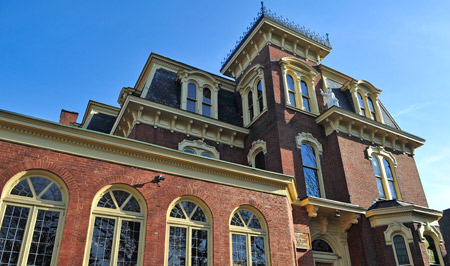
Category Archive: Pittsburgh Tribune Review
-
Real Estate Notes
By Sam Spatter, FOR THE PITTSBURGH TRIBUNE-REVIEW
Sunday, February 6, 2011
• An $215,000 agreement with Pittsburgh History & Landmarks Foundation to provide design and construction management for Downtown buildings has been approved by the Urban Redevelopment Authority. Services may include facade renovations, core and shell and life safety improvements, and elevator renovations or installations. The goal is to stimulate occupancy on upper floors in buildings that often have a tenant only on the first floor. Examples are the ISDA property at Forbes and Wood streets and Kashi jewelers, 253 Fifth Ave. -
Civic Arena a ‘Symbol of Genocide’
By Bill Vidonic
PITTSBURGH TRIBUNE-REVIEW
Thursday, February 3, 2011Former City Councilman Sala Udin was among the 8,000 residents and businesses in the lower Hill District who were displaced in the 1950s for construction of the Civic Arena.
On Wednesday, he urged Pittsburgh’s Historic Review Commission to reject a push to grant the arena protection under the city’s historic structure preservation law.
“This is more a symbol of genocide than a historic icon,” Udin said. “Demolish the arena and let the promise begin.”
During more than four hours of testimony, preservationists said that the arena’s distinct domed shape, its engineering and its place in the fabric of Pittsburgh’s history should spare it from a wrecking ball.
The city-county Sports and Exhibition Authority, which owns the building, and city Planning Commission have voted to demolish the building. The SEA had hoped to start in April, but the nomination for historic status has delayed that.
“There’s nothing like it anywhere else,” said Eloise McDonald of the Hill District, one of the people who nominated the structure in November. “That’s what makes it historical.”
Franklin Toker, a University of Pittsburgh art and architecture professor, said development and construction of the arena in the 1950s and ’60s coincided with “the most exhilarating, most creative and most ambitious moment this city has ever known: the Pittsburgh Renaissance.”
“It is the branding image for Pittsburgh, right under our noses,” Toker said.
A 2007 agreement between the Sports and Exhibition Authority and the Pittsburgh Penguins gave the sports franchise development rights for the 28-acre site.
Various representatives outlined a long-term redevelopment plan — one in which the arena is leveled — to make way for residential, retail and commercial development, creating thousands of jobs and millions of dollars in tax revenue.
City Councilman R. Daniel Lavelle, who represents the Hill District, said there’s no redevelopment plan for the arena itself.
“The hard truth is that the Civic Arena remains a symbol of failed public policy and a continual deterrence to economic viablility for the Hill District community. Historic designation and preservation, for many reasons, is not the correct decision. On the contrary, what might be more appropriate at this time is an apology for the historic injustices that were heaped upon the Hill District when it was torn asunder nearly a half-century ago.”
The city rejected historic status for the structure in 2002. The Historic Review Commission could make a recommendation next month; the city’s Planning Commission and City Council still must consider the request, a process that likely will stretch into summer.
-
Landmarks Foundation Waits for Word on $4 Million State Grant
By Craig Smith
PITTSBURGH TRIBUNE-REVIEW
Wednesday, February 2, 2011
Arthur Ziegler, president of the Pittsburgh History & Landmarks Foundation, surveys Fifth Avenue, Downtown, part of an area his group has earmarked for more redevelopment like its Market at Fifth project. The foundation is awaiting word on whether a $4 million state grant from former Gov. Ed Rendell's administration will come through. Gov. Tom Corbett is reviewing that grant and others like it. Keith Hodan | Tribune-Review
Arthur Ziegler Jr. likes what he sees Downtown.
Seven apartments and two retailers occupy three historic buildings that were brought back to life through a $3 million Pittsburgh History & Landmarks Foundation project dubbed Market at Fifth. More projects in the area could come to fruition if a $4 million state grant comes through.
“I am very pleased … the momentum is gaining,” said Ziegler, the foundation’s president.
Ziegler hopes to leverage the $4 million grant from former Gov. Ed Rendell to do more historic renovation work. Gov. Tom Corbett, who took office last month, is reviewing the grants, handed out in the final days of the Rendell administration through the state’s Redevelopment Assistance Capital Program, or RCAP.
The money was committed to Pittsburgh for historic building facade and core shell restoration, Ziegler said. The city appointed the landmarks foundation to carry out the work.
“It would be a great project for the city and Downtown,” said Rob Stephany, executive director of the city Urban Redevelopment Authority.
Some leaders criticized Rendell’s use of the RCAP grants, which come from borrowed money. Corbett said before he took office he would review all of the grants Rendell approved at the end of his term.
“We’re trying to go through the RCAPs as quickly as possible to make a decision,” said Kevin Harley, spokesman for Corbett.
Other areas of the country are successfully using historic renovation to spur development.
“We’re seeing a real move back to our center city — businesses and residents,” said Kevin Schwab, vice president of communications for CenterState Corp. for Economic Opportunity in Syracuse, N.Y.
Since the late 1980s, the downtown population has doubled from 1,000 to 2,000 people and 16 of 18 condos near a historic district have been sold, Schwab said. In the past decade, the revitalization has gained momentum, even during the recession, he added.
“It has all been driven by the rehabilitation of buildings that have been deemed historic,” he said.
New buildings are going up “with an eye toward being in concert” with what is already around them, he said.
If the $4 million grant for Pittsburgh survives Corbett’s review, the landmarks foundation plans to augment it with donated funds “so we can really solidify the new quality retailing we introduced with Market at Fifth,” Ziegler said.
“We would like to double (the $4 million),” he said.
The money would be used to renovate a half-dozen historic buildings scattered in the Fifth and Forbes area that have been scheduled for preservation since the days of former Mayor Tom Murphy, Ziegler said.
The Market at Fifth project restored three buildings within the Market Square historic district, including the former Regal Shoe Co., which opened in 1908.
The Regal building was designed by Alden & Harlow, then one of the city’s prominent architectural firms, responsible for the Carnegie Institute and Library additions in Oakland, and Carnegie branch libraries in various communities.
Its chief designer was one of the firm’s principals, Frank E. Alden, who in the late 1800s worked with architect H.H. Richardson supervising construction of noteworthy Downtown buildings such as the Allegheny County Courthouse and the Allegheny County Jail.
-
Row-House Museum Harrison Group’s Top Goal for 2011
By George Guido,
FOR THE VALLEY NEWS DISPATCH
Wednesday, January 26, 2011Bill Godfrey of Natrona Comes Together, the grassroots neighborhood improvement group, says the group has a list of goals for this year for this aging, riverside neighborhood that’s nestled between two steel mills.
One is establishing a row-house museum on Federal Street.
The project would restore a row house to its original state and be operated by the Pittsburgh History & Landmarks Foundation.
Residents have been donating artifacts to the proposed museum, but the discovery of a $6,000 tax lien on the property possibly could complicate the project.
A steel heritage sculpture is proposed for the corner of Federal and Blue Ridge Avenue.
Natrona Comes Together needs $1,300 to buy the vacant property.
The sculpture will resemble the coal miners’ memorial sculpture in the Harwick section of Springdale Township and will be sculpted by New Kensington native Steven Paulovich. The parklet will be managed by the Rivers of Steel Group, based in the Mon Valley.
Another project involves ongoing additions to the Natrona playground.
A concession stand, bike racks, landscaping and a horseshoe-pitching court are among the planned items for the $142,000 federal grant.
Godfrey’s group hopes to have the former bank building renovated to the point where it could be sold, rented or leased to a private business.
The Natrona group also hopes to get AmeriCorps members to help manage the park and mow grass on vacant properties in the community.
-
‘Location’ is Only Part of Marketing Downtown Homes
By Bob Karlovits, PITTSBURGH TRIBUNE-REVIEW
Sunday, January 9, 2011
The condos at Gateway Towers, Downtown, offers postcard-like views of PNC Park, Point State Park and the headwaters of the Ohio River. Joe Appel | Tribune-Review
Cindy Clifton stands at the corner of a condo in Gateway Towers overlooking postcard-like views of PNC Park, Point State Park and the headwaters of the Ohio River.
What sells this $1 million condo, like others that can be about $200,000 in the Downtown high-rise, is what has become a mantra of real estate sales, the building manager explains: “Location, location, location.”
But at the same time, she adds, the management of the building also recently spent about $80,000 to bring the lobby, hallways and other public spaces out of the 1950s. It is an attempt to make the building “hipper” and to compete with some other, newer residences.
The need to make a lobby more attractive, to have it “say” something, points to a twist in the marketing of Downtown’s places to live. The vertical lifestyle Downtown creates a different market than the lawns and properties of the suburbs. For many, that upkeep is the reason for leaving the suburbs.
Liz Caplan, real estate broker for Remax, says there is one requirement that is shared in all Downtown homes.
“People want a worry-free lifestyle,” she says. “They don’t want to worry about the garden or cutting grass. They want to be able to take off for a couple weeks in Florida without thinking about anything.”
Debbie Roberts, general manager of the Cork Factory apartments in the Strip District, says urban living is “not for everyone” and those who accept it also are lured by the features their building offers.
Frank Berceli, from the firm that handles leasing for the Heinz Lofts on the North Side, says those amenities are even more important than higher or lower rents or mortgages.
“If your dealing with a person who can afford $1,300 for rent, $50 more or less won’t matter,” he says. “But a good workout room will.”
Roberts says the Cork Factory thrives on amenities such as the picnic area, a marina and the building’s historic architecture
But, she adds, its closeness to Downtown also makes it attractive even if it is not right in the business district.
Similar comments are made at many Downtown residences, pointing to sales pitches that are far different from those for single-family homes.
Those pitches also point to how these buildings would seem to present different lifestyles, even if they seem similar.
It is all in what is offered
Both David Bishoff and Frank Berceli are big on privacy — but even that can take on a different nature.
Bishoff is president E.V. Bishoff Co., the Columbus, Ohio, firm that developed the Carlyle condos at Fourth Avenue and Wood Street. Berceli is general manager of Amore Management of Monroeville, which leases homes at the Heinz Lofts.
They both say they market their residences as offering a form of “privacy,” but Bishoff brags about how his “privacy” is amid bustle. Berceli’s, meanwhile, is in a suburb in the city.
Bishoff says one of the strongest aspects of the Carlyle is the 14 to 18 inches of concrete above and below condos and the walls that are lined with sound-deadening material. That makes the silence in the condos similar to that which residents experienced in their suburban homes before they moved Downtown.
“We don’t want to listen to our neighbor’s stereo,” he says of life in the condos, many of which cost about $300,000. “We did that in college, but we don’t want to do it now.”
Still, though, he adds, the Carlyle is in the middle of town, blocks from restaurants, shows, shops and health clubs. That gives it a location in the middle of activity that has lured many of its residents.
Berceli, on the other hand, says his clients tend to want to get away from urban life, but remain close enough to dip into it at a whim.
For that same reason, Berceli continues, the Heinz Lofts provide a better workout facility: it allows residents to stay at home instead of going to a commercial gym, no matter how close.
By living on the other side of the Allegheny River, the noise of traffic and business activity is gone. But the Downtown life is minutes away when it is wanted.
He says Heinz Lofts tenants are lured by that quiet as well as such features as the bicycle-hiking trail in front of it.
The ‘product’ is everything
William Gatti, president of Trek Development, which owns the Century Building on Seventh Avenue, Downtown, says the total “product” is the most important element in the marketing of a Downtown home.
Apartments there range from $600 a month rent-control units up to $1,500, and are being taken mostly by people who work Downtown or, in some cases, are retired but active as docents or other volunteer jobs.
“It puts people on the street,” he says. “They are out there going to work or going to restaurants. It is part of the whole urban lifestyle.”
He knows of some people who use Downtown residences as a part-time city home and suggests that strategy does not create a lively Downtown.
Brett Malky, a partner in 151 First Side, the upper-end condos on Fort Pitt Boulevard, says ultimately the “success” of all the Downtown residences is one of the best ways of marketing Downtown living.
“It is a lifestyle choice, but the fact that there are places appealing to young workers or empty nesters makes it possible to market Downtown living,” he says.
As he spoke, he was closing in on agreements that would leave only nine units available in the 82-place site that opened in 2007.
For condos that can top $1 million, that bespeaks the success he sees.
“With the small number left, it shows the fear of living Downtown is over,” he says.
-
Saxonburg Gets $1.4 Million for Main Street
By Tom Fontaine
PITTSBURGH TRIBUNE-REVIEW
Friday, January 7, 2011Saxonburg has received a $1.4 million state grant to make long-awaited improvements along historic Main Street without robbing any of its 19th century charm.
“We’re going to take new materials and create an atmosphere like it was in the 1850s and ’60s,” said Ray Rush, who will oversee the project for the tiny Butler County borough.
Saxonburg’s grant was the largest of six totaling more than $4.4 million announced Thursday by PennDOT. The agency awarded almost $25 million statewide through its Pennsylvania Community Transportation Initiative. The program provided $59.2 million for transportation projects in 2009.
Saxonburg will use its money to install new curbs, brick sidewalks, planter strips with trees, and period lighting along 1,100 feet of Main Street. That will cover roughly half of the area that is recognized as a historic district both nationally and by the state.
The borough can trace its roots to engineer John Roebling, famed for his designs of wire cable and suspension bridges. He designed and developed Saxonburg almost four decades before he began designing the Brooklyn Bridge in the late 1860s.
“It’s important to celebrate the old. It’s something all communities should be concerned about,” Rush said. The work will begin next fall and should be completed in 2012.
The city of Pittsburgh will receive $280,000 for a traffic study in the Strip District and Lawrenceville related to its Allegheny Riverfront Green Boulevard development project. The city wants to help make its largely industrial Allegheny riverfront home to lush green spaces, trails, housing, commercial development and commuter rail.
“This most recent grant will allow us to continue the positive momentum that is happening in these vibrant neighborhoods,” said Mayor Luke Ravenstahl.
Other grant recipients include:
• Richland, $1.3 million, to improve pedestrian access and traffic flow near the intersection of Route 8 and Ewalt Road.
• Airport Corridor Transportation Association, $700,000, to reduce congestion and provide better transit, pedestrian and bicycle access in the Robinson and North Fayette commercial area.
• Washington County, $443,500, to develop 9 miles of recreational trail to complete the Panhandle Trail between Carnegie and Weirton, W.Va.
• Armstrong County, $300,000, to perform a traffic study in Kittanning.
-
Honus Wagner Sporting Goods, Downtown, to Close After 93 Years
By Sam Spatter, FOR THE PITTSBURGH TRIBUNE-REVIEW
Wednesday, January 5, 2011
The Honus Wagner Sporting Goods store will be closing its doors after 93 years of business. The store was started in 1919 by former Pittsburgh Pirates players Honus Wagner and Pie Traynor, and relocated to Forbes Avenue in the mid-1960's. Philip G. Pavely | Pittsburgh Tribune-Review
Honus Wagner Sporting Goods store, Downtown — started by the Pirates baseball legend 91 years ago — is closing.
Harriet Shapiro, who with her husband Murray are the fourth generation to own the store, confirmed Tuesday the closing by phone from her Florida home. She said “there was no one in her family willing to operate the store.”
Plans are to begin a “Going-out-of-Business” sale within the next few days — or by the end of the week, a sale that could last for up to 60 days.
The building, at 320 Forbes Ave., is under option to be purchased by Point Park University. About 10 are employed at the store, Shapiro said.
The store was closed Monday and Tuesday for the staff to take inventory, said Joe Melcher, floor manager.
The store will be reopened at 10 a.m. today.
Melcher said the economy probably had more of an impact over the past year on sales than did major sporting-goods stores, such as Dick’s Sporting Goods, although it did have some impact on sales.
“If Dick’s had a Downtown location, the impact might have been more,” he said.

The floor manager at Honus Wagner Sporting Goods, in Downtown heads to the back of the store to discount merchandise Tuesday. The store will be closing its doors after 93 years of business after being started in 1919 by former Pittsburgh Pirates players Honus Wagner and Pie Traynor and relocated to Forbes Avenue in the mid-1960's. Philip G. Pavely | Tribune-Review
The Honus Wagner store dealt mainly in shoes and sports apparel, although it did some business in team-licensed goods, Melcher said.
The store usually is open from 10 a.m. to 5:30 p.m. Mondays through Saturdays. The store is closed Sundays, except for home Steelers games, Melcher said.
“It’s always unfortunate that a Pittsburgh institution, such as Honus Wagner Sporting Goods closes, but with the generational change, those things happen,” said Mike Edwards, CEO of the Pittsburgh Downtown Partnership, a group of business and community leaders, property owners, civic organizations and residents that promotes Downtown interests.
The store always seemed “surprisingly busy,” Edwards said.
The store was started in 1919 — at 813 Liberty Ave., Downtown — by former Pittsburgh Pirates players Honus Wagner and Pie Traynor, two years after Wagner retired, said Shapiro.
Wagner is widely regarded as one of Major League Baseball’s greatest players. He was one of five players inducted into the Hall of Fame in its inaugural Class of 1936.
Although the store carried the Honus Wagner name, that wasn’t enough to make the business a success — even with Wagner occasionally stopping at the store in the 1920s.
In 1928, the store was in bankruptcy. That year, Shapiro’s father, E. Louis Braunstein, purchased it. At one time, Braunstein operated 15 stores, she said.
In the mid-1960s, the store was relocated to its present site on Forbes Avenue, said Shapiro.
“The problem of a single-store retailer is that it does not have a lot of leverage with its vendors,” said Sam Poser, senior retail analyst with Sterne and Agee, based in New York. “If traffic is slow and there’s a lot of inventory but cash is slow, the single-store operator can easily be impacted by the national economy.”
Poser covers such retailers as Dick’s, Columbia Sportswear, Hibbett Sports Inc., Nike Inc. and Wolverine World Wide Inc.
Johannes Peter “Honus” Wagner was a Carnegie native who played Major League Baseball for 21 seasons — from 1897 to 1917. Wagner was with the Pirates for all but the first three of those seasons.
The shortstop won eight batting titles and batted .300 or better for 17 consecutive seasons. He played in nearly 2,800 games; had 10,450 at-bats; recorded 3,430 hits; and amassed a .328 lifetime average. He had 651 doubles, 252 triples and 722 stolen bases.
A Honus Wagner statue originally was outside Forbes Field in Oakland and later stood at Three Rivers Stadium. The statue was moved to PNC Park after the new North Shore ballpark opened in 2001.
Born in 1874 in Mansfield — which merged with Chartiers in 1894 to become Carnegie — the Pirates legend died Dec. 6, 1955, while living in Carnegie.
A nearly mint condition Wagner baseball card sold in 2007 for $2.8 million — believed to be the most ever paid for a baseball card. Another one, in poor condition, sold for $262,900 in November.
-
Pitt Class to Nominate Bloomfield School for Historic Registry
By Adam Brandolph
PITTSBURGH TRIBUNE-REVIEW
Monday, December 13, 2010
The Ursuline Academy (dates back to 1894), a Catholic girls school, opened in its Bloomfield location in 1894 and closed in 1981. In 1993, the building was sold, restored and named Victoria Hall, a venue for weddings and celebrations. The Waldorf School bought the property in 2003. Sidney Davis | Pittsburgh Tribune-Review
The ornate wood and plaster work inside the former Ursuline Academy in Bloomfield has been around for about 140 years.
A nomination to the National Register of Historic Places next month could ensure it lasts at least twice as long.
The building on South Winebiddle Street near the borders of Friendship Park, Garfield and Lawrenceville has been a hands-on laboratory for University of Pittsburgh students learning how to research historic buildings. The students will release their findings to the public at 7 p.m. Tuesday in the building’s auditorium.
The class plans to present the nomination to the Pennsylvania Historical and Museum Commission in January. If approved, the commission would send it to the National Park Service in Washington for a final review.
Officials with the building’s current tenant, the Waldorf School, a private school for students in kindergarten through fifth grade, applaud the efforts.
“It’s a wonderful place to have a school,” said Alexandra Gruskos, Waldorf’s board president and an attorney for the Allegheny County Office of Children, Youth and Families. “We’re very happy about the nomination.”
Students in Jeff Slack’s documentation and conservation studio course pored over historic maps, photographs, deeds and building permits in researching the history of the 21-room mansion built for Henry J. Lynch in the late 1860s.
“The nomination is the result of the ongoing work begun in 2008 by Pitt preservation students that included a detailed evaluation of the physical condition of the building,” Slack, a historic preservation planner at Pfaffmann + Associates, PC, Downtown, said in a written statement.
“But this year, the students’ work focuses more so on research that shows the far-reaching educational contributions of the Ursuline Academy to the local community.”
The historic designation would prevent federal money from being used to alter the building, said Brendan Froeschl, facilities manager for the Waldorf School. The building was well-preserved because it was turned into a school after initially being a residence, he said.
“The Ursulines did a wonderful job. When you come in the front door, you’re in the front door of the original mansion,” Froeschl said.
Dan Holland, director of the Young Preservationists Association of Pittsburgh, said other buildings across the city would benefit from the expertise of the class.
“To do this kind of work is a huge help,” Holland said.
The Ursuline Academy, a Catholic girls school, opened in its Bloomfield location in 1894 and closed in 1981. In 1993, the building was sold, restored and named Victoria Hall, a venue for weddings and celebrations. The Waldorf School bought the property in 2003.

